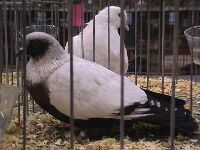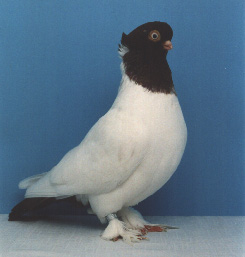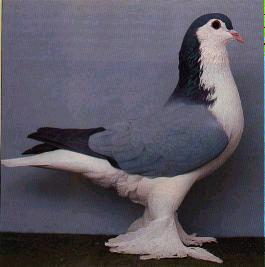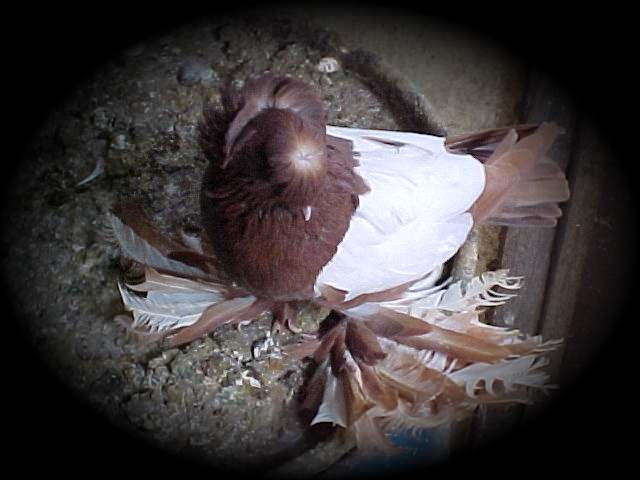CARE OF A LOST PIGEON
by Frank Mosca
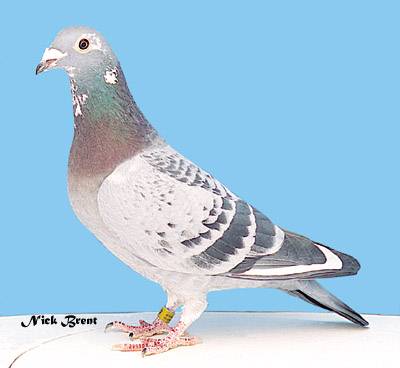
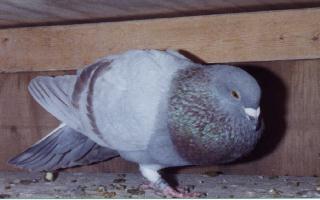
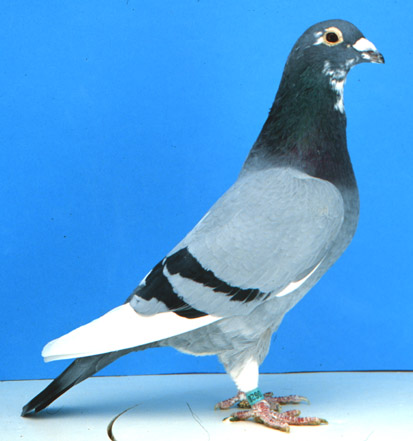
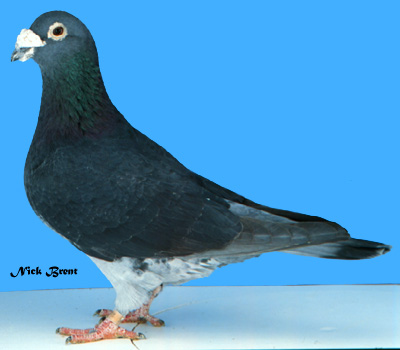
(Pied or splash simply means the bird has some
white on it.
If there were no white, it'd be a blue bar; blue check, etc.)
Just click on them to go to their sites.
Water
Most lost birds are hungry and thirsty. Water is necessary before all else. Since pigeons drink by suction, any water container should be at least 1 in. (2.5 cm) deep. An open container, i.e., a dish, an old margarine container tub, etc., is best. While a thirsty bird may drink immediately, it also may not. A bird that's gone without water for a while is sometimes so exhausted, it doesn't even realize that water is in front of it, especially if the water container you use is different from what it is familiar with. A trick I've often used is to trickle a few drops of water from on high into the container to make a splashing sound. When they hear that, most birds will invariably head to drink. If a bird looks really exhausted, Gatorade or other proprietary sports drink may be added to the water. A teaspoon or two per cup (250 ml) of water will help replenish electrolytes.
Pigeons are grain eaters. While park pigeons will eat bread, most domestic birds have been raised on a multi-grain mixture and have never seen a slice of it. In fact, they would likely ignore it as possible food. Try feeding them something else from around the house. Popcorn (maize), rice, white or brown, split peas, barley, buckwheat (kasha), canary seed, etc., are all good first options to feed a lost bird with. THESE GRAINS SHOULD NOT BE COOKED OR POPPED BUT FED RAW. Water should also be provided since pigeons normally drink immediately after eating.
What Should I Keep It In?
Any container that a dog or cat can't get into will be fine. An old bird cage will hold the pigeon for a day or so with no problem, as will a cardboard box - a screen on top of such a box is better than simply closing the flaps since there will then be enough light for the bird to see to eat and drink.
If the bird has a band on its leg,you can sometimes trace its owner through one of the national pigeon organizations. However, this is often not even necessary. After twenty-four to forty-eight hours rest with food and water, most homing pigeons are more than capable of finding their way home on their own. If it looks very strong and active simply release it in an area free of wires or other obstacles and it will usually head home immediately. NEVER try to attach a note to the owner by rubber banding it to the bird's leg. This merely cuts off the leg's blood circulation and often leads to gangrene and amputation of the limb. If you do want to attach a small note, tie it carefully to the middle two tail feathers. Do not release non-homing pigeons, since most of those have little or no homing instinct and are probably out because a door was left open. If released, they will likely not make it.
What if it won't/can't go home?
Many birds can be traced to their owner by the numbered band (ring) on their leg. In North America, homing pigeons normally carry bands with a combination of the year plus the initials: Go to each site listed below and look for their Lost Bird or Band List.
A.U. - American Racing Pigeon Union
I.F. - International Federation
Outside of North America, racing homers can be traced through the national racing club of the country of origin.
Birmingham Roller Pigeons look to non-fanciers like little racing pigeons. They are often banded with NBRC bands and you can track them through the National Birmingham Roller Club . There are many other regional roller pigeon clubs as well, each with its own band.
There are more than 500 breeds of pigeon. Some fly very well, some don't. Those which carry a band marked with NPA (National Pigeon Association) can sometimes be tracked to the owner. (N.B. Please also see note below. I'm leaving the link up to the N.P.A. only as a courtesy to those kind people trying to help a lost bird.) Many, however, can not because these bands are often sold through feedstores and other outlets where permanent records are not kept.If the bird carries a band with other letters than those listed above for racing homers or for NPA banded birds, it may be privately banded or belong to someone who has banded with a specialty club band. Your local feed store often knows many of the pigeon breeders close to you and can often refer you to one of them. Such individuals often know of local club secretaries who may be able to help you.
If the pigeon you have is unbanded (no way to trace the owner), or, if, after searching, and not finding the owner, you decide you'd like to keep the pigeon as a pet, by all means do so. Pigeons make fun pets. Many will become extremely attached to you - and you to them. There are many fine books on the market which will help you become a responsible pigeon owner. Just remember a few basics:
1) Clean water, feed, and mineral grit (available at most feed stores).Pigeons must have dry surroundings, they're not ducks. They love a bath, but whatever you keep them in must normally be bone dry.
Enjoy one of the most fun animals alive.
AUTHOR'S NOTE: Over the years, I've noticed others have often simply copied this page at their own site to tell folk how to care for lost birds, sometimes with very minor modifications. Almost invariably, those sites have been kind enough to ask me for permission - which I've always granted - or they've had the decency to list me as the author. I've never had any problem with that. The U.S. N.P.A., however, has never responded to any of my many requests that they at least list me as author of the information. I'm simply noting here, that ethics aside, it appears the lack of any followup to me either seems to provide a good insight into the running of the group itself. -- 07/2007
